
| What is Flavor and Fortune? |
| How do I subscribe? |
| How do I get past issues? |
| How do I advertise? |
| How do I contact the editor? |
Read 12937393 times
Connect me to:
| Home |
| Articles |
| Book reviews |
| Letters to the Editor |
| Newmans News and Notes |
| Recipes |
| Restaurant reviews |
| Article Index (all years, slow) |
| List of Article Years |
| Article Index (2025) |
| Article Index (last 2 years) |
| Things others say |
| Related Links |
| Log In... |
| Authors |
| Categories & Topics |
Anhui and Zhejiang,Two Classic Culinary Provinces
| by Jacqueline M. Newman |
Regional Foods
Summer Volume: 2013 Issue: 20(2) pages: 10 to 13
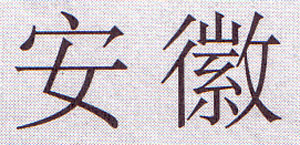 ANHUI is an agricultural province, loaded with lots of dramatic scenery. There are hills and mountains to the south and west while the north is more, but not completely flat. Classical artists adored painting the scenery of this province; one such published with this article. This province is the place where Laozi, the founder of Taoism, came from. So did Zhuang Zi, a most famous philosopher. Both increased knowledge about how to live and about their province, as have others. Established early in the Qing Dynasty, in 1667 to be exact, it did have a difficult past because it was ravaged by many floods, one of the worst in 1194, also many droughts.
ANHUI is an agricultural province, loaded with lots of dramatic scenery. There are hills and mountains to the south and west while the north is more, but not completely flat. Classical artists adored painting the scenery of this province; one such published with this article. This province is the place where Laozi, the founder of Taoism, came from. So did Zhuang Zi, a most famous philosopher. Both increased knowledge about how to live and about their province, as have others. Established early in the Qing Dynasty, in 1667 to be exact, it did have a difficult past because it was ravaged by many floods, one of the worst in 1194, also many droughts.
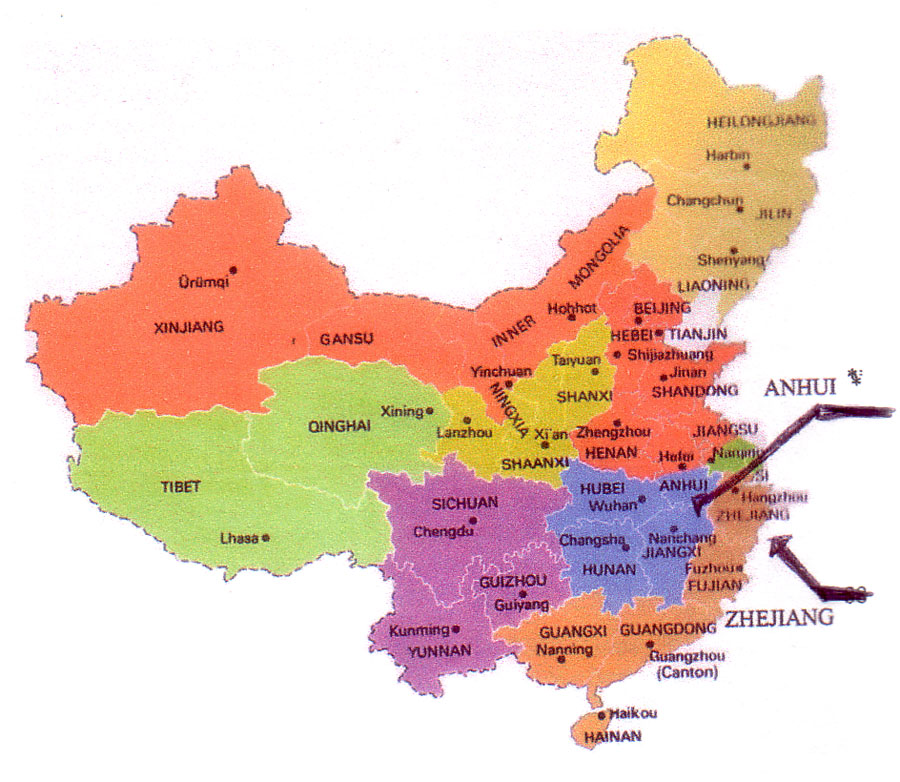 Named after two prefectures, Anqing and Huizhou, the latter now called Huangshan, almost seventy million people live in this landlocked university-rich province that borders on the Hunan and Hubei Provinces on the west, Jiangxi to its south, Shandong on the north, and the Zhejiang and Jiangsu Provinces on the east. All have added culinary influences to those of the Anhui cuisine, known for short as Wan.
Named after two prefectures, Anqing and Huizhou, the latter now called Huangshan, almost seventy million people live in this landlocked university-rich province that borders on the Hunan and Hubei Provinces on the west, Jiangxi to its south, Shandong on the north, and the Zhejiang and Jiangsu Provinces on the east. All have added culinary influences to those of the Anhui cuisine, known for short as Wan.
Foods here are one of eight major culinary influences in China. Besides that of its Wan cuisine, the others, in alphabetical order, are the provinces of Fujian, Guangdong, Hunan, Jiangsu, Shandong, Sichuan, and Zhejiang. Not everyone touts the same eight as the most famous ones. Some say the city of Shanghai is one, others include Guangzhou. One group of eight discussed in the 2001 Chinese Cuisine Recipes and Their Stories published by Beijing Foreign Language Press lists: Fujian, Guangdong, Huizhou, Hunan, Shandong, Sichuan, Suzhou, and Zhejiang. There are still other groups of eight, so unanimity on what culinary cultures are most famous or most important simply does not exist.
This cuisine has many well-known dishes, including lots with wild herbs. Some are land specialities, others from the sea, some resemble those of Jiangsu, others of different neighbors from the Yangtze and Huai River regions. They are loved by the mainly Han population who live here and do include tastes from Huizhou and Tunxi, and from the Zhuang local minority people. Many of the local popular dishes feature fresh water fish or shrimp and poultry dishes, and many are smoked or seasoned with sugar and/or vinegar
This sub-tropical region has four seasons that are not equal in length. Spring and Fall are quite short. The province has one of China's 'four furnace' locations, that is in Wuhan. The other three are in Changsha, Chongqing, and Nanjing. All four are so hot that some say people can fry an egg on almost every sidewalk or road in town.
The capital city of Anhui is Hefei, now spelled Hebei. It is called the 'green' city and is in lower reaches of the Yangtze River, between the Yangtze and Huai Rivers. It is almost in the middle of the province, and called green because a mite more than one third of its almost three thousand square miles are wooded.
More than five million residents live in Hebei. It is a major stop on the Bengbu-Yuxi Kou Railway. Quite ancient, it did become a commercial city two thousand years before any rail lines were laid. This city has contributed much to China's commerce and culture.
The major rivers mentioned above provide much water for the province's agriculture. They grow lots of rice, wheat, and tea, many kinds of vegetables, particularly those grown for their oil. The waters of Chaohu Lake, one of China's five largest fresh water lakes, and the above two rivers provide lots of water, though the lake is quite polluted now. In addition to food, the province produces much coal, other minerals, and many non-agricultural items.
Hebei is the political, economic, cultural, and transportation center of the province. It is known for many special dishes including Luzhou Roast Duck. Another popular dish is Hotchpotch, shown with this article, it has many red peppers. Some locals prepare it with sea cucumber, fish maw, squid, chicken, pork, dried scallops, dried shrimp, pig tripe, bamboo shoots, dried bean curd rolls, many fungi, pigeon eggs, and seasonings. Boiled Crucian Carp from the Baohe River, and smaller Crisp Crucian Carp from there and elsewhere are made with soy sauce and lotus roots; these are popular too. So is San He Xia Hu made with tiny white shrimp, sanhe-style, with rice flour, leeks, and soy sauce. What fascinates about this dish it that is made salty and eaten with a spoon.
Hodge Podge, another way to spell this dish, is made by some as a sweet and salty soup. Touted to be consumed at Reunion Dinner and always associated with it, it is loved year round in this province. So is local egg dumplings wrapped in sheets of fried egg. They can be filled with pork, steamed and served with soy sauce. Loved, too, is Chicken with Chestnuts, Prawns in Nest, Taro with Honey, Mabing, their sesame cakes, and Baiqie--white sesame slices; as are two special teas, black tea from Qimen and local green tea from Huangshan.
In this provincial city of Wuhu, Steamed Hilsa Herring, Braised Crabs made with meat balls, and Crab Meat and Shrimp Cup are loved, too. This last item is steamed, stuffed, and served in wine cups. In Wushan, they adore salty goose, and have since Tang Dynasty times (618 - 907 CE). There are other popular foods, many include bayberry, stone frog, pangolin, white bamboo shoots, and soft-shelled turtle often prepared with lard, black pepper, pork, garlic, shallots, and fresh ginger.
Wild animals are specialities here, many coming from the Huangshan, Tianzhu, Juihua, and Langya mountains. They can be steamed, sauteed, smoked, or stir-fried; as are stone frogs from the caves in the Huangshan Mountains, stewed soft-shelled turtles and carp fished from local lakes and rivers, stewed stone fungus found in the Lushan mountain region, and Mandarin Fish served smoked and with Maofeng tea. Many of the mountain dishes are made with osmanthus flowers found in capital city of Hebei or in local hills nearby. Traditional Chinese medicinal doctors say they are good for the complexion and valuable to rid the body of poisons.
Anhui people love their Bagong Mountain Bean Curd. Legend has it that this two thousand year old dish was made by King Huaian Liu An who ruled during the Han Dynasty (206 BCE - 220 CE). In fact, he was looking for some food for his own immortality but failed to find anything, but in the process did invent bean curd.
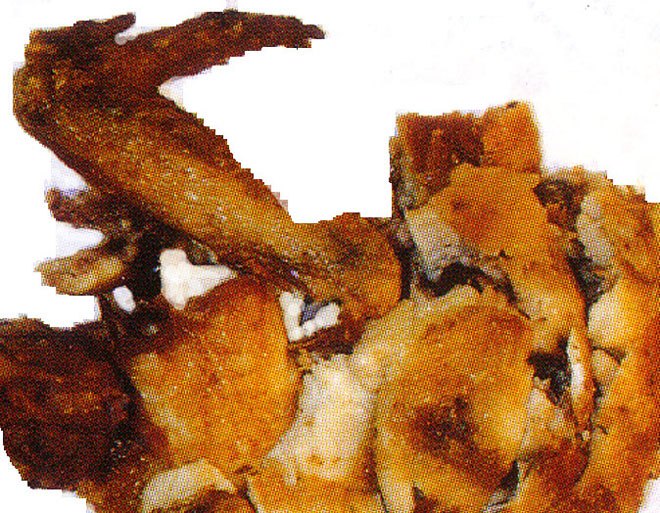 Cao Cao Chicken, named after a general of the State of Wei, is another famous dish from Hebei. It became popular during the Three Kingdoms period (220 - 280 CE) when an army fought against Sun Quan, the King of the State of Wu. The story told is that the King came to Luzhou now called Hebei, and there fell ill with an excruciating headache. His herbal doctor had his chef cook him a chicken with some eighteen different herbs. He ate this bright red roasted bird and it did help him recover, hence this dish's popularity. Like local roasted duck, it is eaten with pancakes as is Beijing Duck.
Cao Cao Chicken, named after a general of the State of Wei, is another famous dish from Hebei. It became popular during the Three Kingdoms period (220 - 280 CE) when an army fought against Sun Quan, the King of the State of Wu. The story told is that the King came to Luzhou now called Hebei, and there fell ill with an excruciating headache. His herbal doctor had his chef cook him a chicken with some eighteen different herbs. He ate this bright red roasted bird and it did help him recover, hence this dish's popularity. Like local roasted duck, it is eaten with pancakes as is Beijing Duck.
Easy to make, Anhui recipes use easily obtainable ingredients; some are at the end of this article. They and other local foods are adored here and in many other places in China.
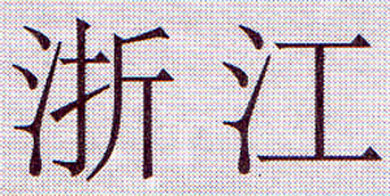 ZHEJIANG is on China’s southeast coast and includes some three thousand offshore islands including Zhoushan, China's third largest. These and the mainland are home to Zhe cuisine, another of China's eight major culinary traditions. Included are foods from the mountains and flatlands, foods from its capital city of Hangzhou, and its second largest city, Ningbo. Also included are foods from Shaoxing. Some historians add foods from Wenzhou, others do not.
ZHEJIANG is on China’s southeast coast and includes some three thousand offshore islands including Zhoushan, China's third largest. These and the mainland are home to Zhe cuisine, another of China's eight major culinary traditions. Included are foods from the mountains and flatlands, foods from its capital city of Hangzhou, and its second largest city, Ningbo. Also included are foods from Shaoxing. Some historians add foods from Wenzhou, others do not.
Zhejiang, called 'crooked river' in Chinese, boasts more than fifty-five million inhabitants and lots of fertile land. It is south of the Yangtze River and the Fujian Province, north of the Jiangsu Province, and west of the Anhui and Jiangxi Provinces. Its foods, here called Zhe, include many famous dishes including West Lake Fish, known for its vinegar sauce, Dungpo Pork, Beggar's Chicken, and Shrimp with Longjing Tea.
Many of these dishes were written about in previous issues including in Volumes 3(1) on pages 13 and 21 and Volume 5(2) on page 8, respectively. There were also articles about Hangzhou, Shaoxing, Ningbo, and this province in earlier issues. Look for them in the Index listings.
Hangzhou with its almost ten million people is the provincial capital. It was once described by Marco Polo as "the most splendid city in the world." Foreign tourism did and still flourishes here as does trade. It has many rivers and lakes, considerable land at the foot of its beautiful mountains, is bordered by Taihu Lake in the north and the East China Sea in, you guessed it-the East. The province has been well known for more than five thousand years, though by the name of Liangzhu, in the distant past.
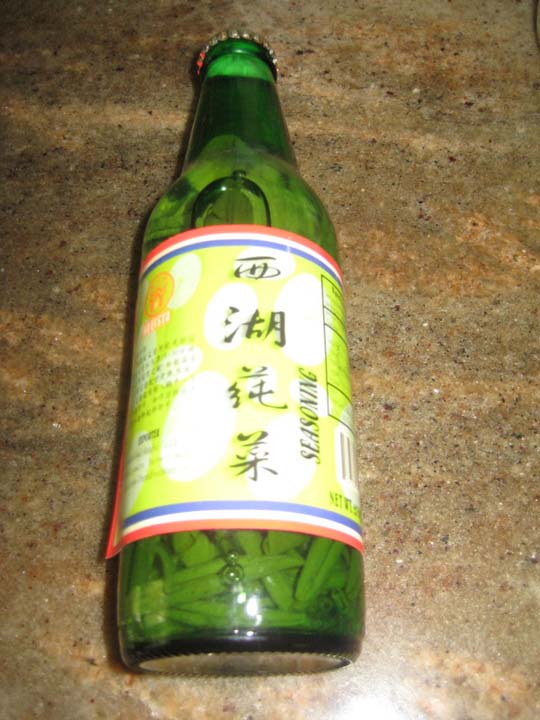 Some seven thousand years ago, Hemudu Man did advance farming here and promote foods from this region, particularly those of its capital city. Many are still made with the local famous Long Jing tea, also known as Dragon Well Tea. Those who know the province, know and adore its water shield vegetable. This Hangzhou delicacy is from the West Lake and is sold elsewhere swimming in small green coke-like bottles. One is seen on this page.
Some seven thousand years ago, Hemudu Man did advance farming here and promote foods from this region, particularly those of its capital city. Many are still made with the local famous Long Jing tea, also known as Dragon Well Tea. Those who know the province, know and adore its water shield vegetable. This Hangzhou delicacy is from the West Lake and is sold elsewhere swimming in small green coke-like bottles. One is seen on this page.
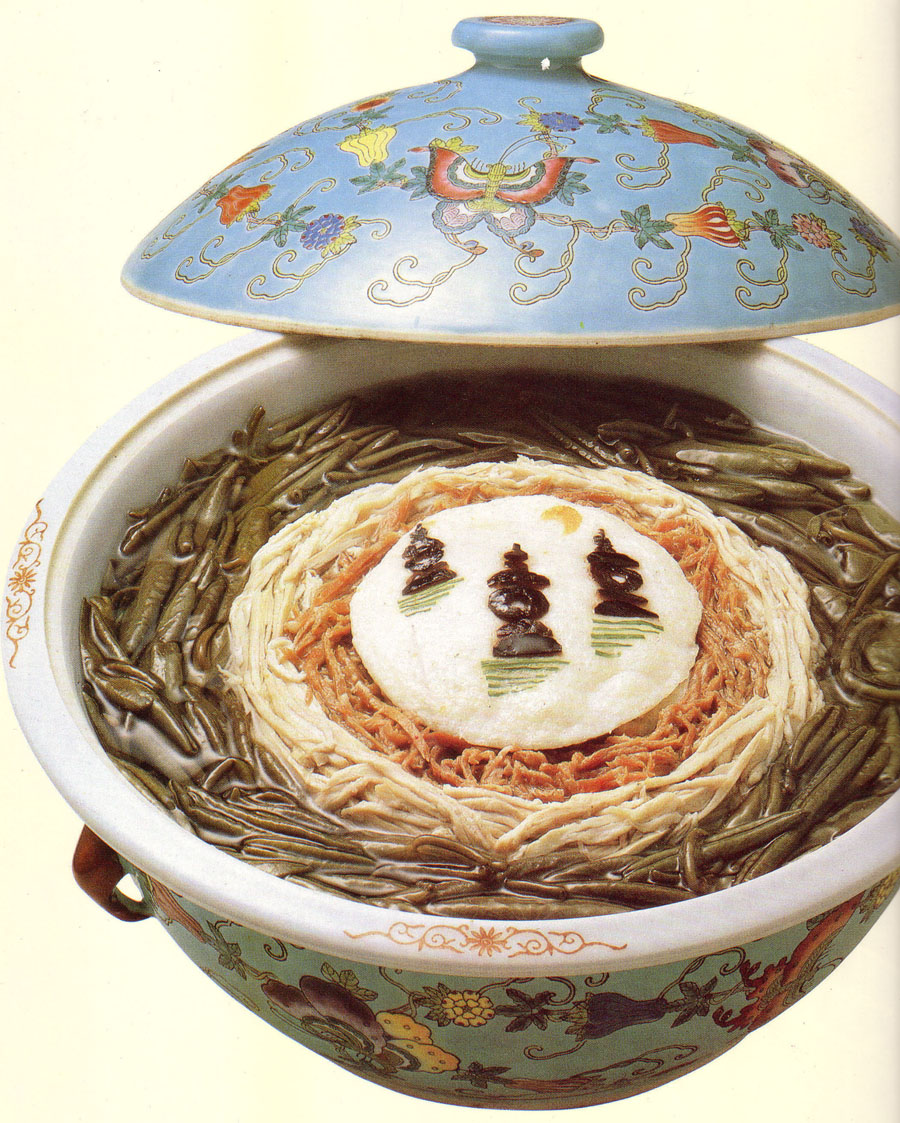 Water Shield Soup uses this aromatic culinary textured unusual treat. Dungpo Pork also originated in Hangzhou; it is boiled for hours with sugar, soy sauce, fresh ginger, onions, and lots of rice wine. This dish originated with a famous poet/scholar of the Song Dynasty named Dung Po. West Lake Beef Soup, also well-known and wonderful, comes from here, too. Another famous local food is Jiao Hua Ji or Beggar's Chicken. Many counties, cities, and towns love this Hangzhou favorite.
The Han majority are more than ninety-nine percent of the province's population along with a small number of Hui and She minority peoples. Zhou En-Lai, China's premier from 1949 to 1976 loved local foods as did Chiang Kai-Shek, another native son. He became President of Taiwan, better known as The Republic of China.
Water Shield Soup uses this aromatic culinary textured unusual treat. Dungpo Pork also originated in Hangzhou; it is boiled for hours with sugar, soy sauce, fresh ginger, onions, and lots of rice wine. This dish originated with a famous poet/scholar of the Song Dynasty named Dung Po. West Lake Beef Soup, also well-known and wonderful, comes from here, too. Another famous local food is Jiao Hua Ji or Beggar's Chicken. Many counties, cities, and towns love this Hangzhou favorite.
The Han majority are more than ninety-nine percent of the province's population along with a small number of Hui and She minority peoples. Zhou En-Lai, China's premier from 1949 to 1976 loved local foods as did Chiang Kai-Shek, another native son. He became President of Taiwan, better known as The Republic of China.
Hangzhou is also famous for many Buddhist and vegetarian dishes including Arhat's Vegetarian Food. It signifies eighteen Buddhist Arhats getting together and enjoying its many dried fungi, day lilies, bamboo shoots, and ever-so-many other items that season this dish. It is said they also love Fried Mock Shredded Eel, Grilled Mock Shark's Fin, and Vegetarian Duck; all made with nary an animal product.
Shaoxing, an old provincial town, is well-known for its wonderful yellow wines. It has two great museums, one dedicated to that yellow wine, the other to three items made in urns. One is that wine, another dye for its silks, and the third is its soy sauce. The museums and the Xianheng Wineshop are not to be missed, nor should a dish simply called Broad Beans. It is made with lots of them, and lots of aniseed. Spiced Dried Bean Curd also comes from here, as does Steamed Mandarin Fish in Clear Soup, the latter swimmings with pork balls, fish balls, bamboo shoots, fish maw, local mushrooms, chicken stomach slices, and other ingredients.
Ningbo is a large and beloved seaside city at the Eastern end of this province. Its Eel in Clear Soup is popular as are its soft-shelled turtles, Preserved Mustard Greens and Yellow Croaker, Deep-fried Goose Livers, Fried Shrimp out of their shells, and Ningbo Dumplings made with glutinous rice flour.
Not to be missed anywhere in this province is the local Jinhua ham. Many local dishes are made with it here and throughout China, perhaps the most famous are Ham and Immortal Duck, Jinhua Crisp Cake, and Ham in Sweet Juice. This last one is loaded with ham, lotus seeds, green plums, cherries, osmanthus flowers, and sugar. Other popular Ningpo dishes are Ham Slices with Cloud Ear Mushrooms, Yipin Diced Pork with Fermented Red Doufu, Fish Head with Bean Curd, and Drunken Chicken.
All of these are absolute musts for those going here during Spring Festival. We have enjoyed them then, and at other times. Also not to be missed in this province are the Spring bamboo shoots. They are prepared rich in sugar and fat, usually lard, and seasoned with sugar, soy sauce, and scallions. Check this magazine's index for many of these dishes, then read and make the Anhui and Zhejiang recipes below. Do enjoy them all!
| Chicken and Chestnuts, Anhui Style |
|---|
3 chicken thighs, skin discarded 2 Tablespoons thin soy sauce 1 Tablespoon dark soy sauce 1 Tablespoon Chinese slab sugar, crushed 2 Tablespoons water chestnut flour 6 large Chinese black mushrooms, soaked in one cup warm water for half an hour 1 Tablespoon vegetable oil 6 cloves garlic, peeled and crushed with side of a cleaver 3 Tablespoons oyster sauce 1 Tablespoon granulated chicken bouillon 2 Tablespoons cornstarch mixed with just one tablespoon cold water 3 Tablespoons goji berries 1 Tablespoon sesame oil 3 Tablespoons of fresh coriander leaves, very coarsely chopped Preparation: 1. Chop each chicken thigh into four pieces, then mix them with both soy sauces, the crushed sugar, and the water chestnut flour and let rest for half an hour. 2. Squeeze the water out of the mushrooms and set them aside after discarding the mushroom stems and quartering the mushroom caps. 3. Heat the oil in a claypot and fry the garlic until lightly browned, about one minute, then add the drained chicken pieces and stir-fry them for two minutes before adding the oyster sauce, chicken bouillon, reserved marinade, the mushroom water, mushrooms, the goji berries and the chestnuts and stir, then simmer covered for twenty minutes. 4. Remove the cover and add the cornstarch mixture and the sesame oil, and stir until it comes to the boil and is thickened. 5. Garnish with coriander leaves, and serve. |
| Shrimp in Nest, Zhejiang Style |
|---|
1 pound shrimp 1/2 pound potatoes 1 Tablespoon cornstarch 1/2 cup vegetable oil 1 Tablespoon hair seaweed 3 stalks Chinese celery with leaves, each cut into four pieces 1/4 cup green soybeans or lima beans 1 large black mushroom soaked for half hour, water squeezed out, the stem discarded, and the cap slivered Preparation: 1. Peel the shrimp and the potatoes, remove veins from the shrimp and set them aside. Cut the potato into thin slices. Then toss each of these with half of the cornstarch, keeping them in separate small bowls. 2. Heat the oil and fry each of these separately, the shrimp for one minute, the potatoes for five minutes. Drain each of them on paper towels. 3. Oil blanch the hair seaweed for one minute and drain it on paper towels, as well. 4. Arrange the celery pieces, leaves to the outside, put the hair seaweed in the center, the potatoes around it. 5. Reheat the shrimp in the oil for one minute and drain them and spread them about. Do the same for the soy or lima beans and the mushroom pieces but for two minutes and spread them about after draining them on paper towels. Then serve warm or at room temperature. |
| Taro with Honey, Anhui Style |
|---|
1 pound large piece of taro 1/2 cup honey 1/4 cup crushed brown sugar Preparation: 1. Peel then cut the taro into thin match-stick strips. Put them in a large bowl on the top layer of a steamer with two inches of water in its bottom. Pour the honey over the taro and sprinkle the sugar over it next. Simmer for one hour or until the taro is soft. 2. Remove the taro with a slotted spoon to a pre-heated soup-type bowl. Put the liquid into a small pot and bring this to a boil, stirring every few minutes until only about two or three tablespoons of liquid are left. Pour this over the taro and serve. |
| Braised Bamboo Shoots, Zhejiang Style |
|---|
1 pound young bamboo shoots, thinly sliced 1/4 cup lard 2 Tablespoons Sichuan pepper-flavored oil 2 Tablespoons sugar, granulated, crushed brown slab or mixed 1 teaspoon thin soy sauce 1/2 teaspoon coarse salt 1 scallion, minced 1 Tablespoon sesame oil Preparation: 1. Crush the slices of bamboo shoots one at a time. 2. Heat the lard in a wok or deep fry-pan, add the bamboo shoots, and simmer on low heat for fifteen minutes, then drain and discard any liquid in the pan. 3. Add the flavored oil, sugar(s), soy sauce, and the salt and one to two tablespoons water, and simmer for five minutes. 4. Put the bamboos shoots in a pre-heated bowl, add the scallion pieces and the sesame oil, stir once, and serve. |

Copyright © 1994-2025 by ISACC, all rights reserved
Address
3 Jefferson Ferry Drive
S. Setauket NY 11720